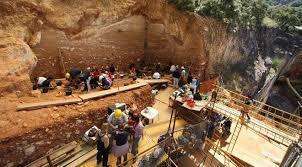
Atapuerca has been excavated for decades, revealing dozens of fossils
Atapuerca is an extremely important Spanish archaeological site, marking one of the first places in Europe our family migrated 1.2 million years ago. There, they flourished for hundreds of thousands of years. It’s also a site riddled with mystery. Many of the fossils look like they’re evolving into Neanderthals, yet their teeth don’t match this pattern. Plus their genetics suggests that they’re about as distantly related to Neanderthals as we are, being more similar to a branch of humanity living on the other side of the continent! How’d they get there?
One of the lesser known mysteries is the fact that, from around 700,000 – 500,000 years ago, the site appears to have been abandoned. Hominins who had happily been living in Spain for almost half a million years just vanished. And what’s most intriguing is that subsequent discoveries have found this is the case all over the continent. Around 700,000 years ago the first Europeans just vanished. Did they die out, or return to their African homeland? And what made them leave? The environment is perhaps an obvious answer, but it doesn’t quite fit. There was a period of cooling during this abandonment, but it didn’t really get going until almost 50,000 years after these hominins humans had vanished.
But it looks like there’s been a breakthrough. Researchers recently published data obtained from the animal remains found at Atapuerca. They estimated the populations of the various species living at the site, and how much food they would have take to survive. Prior to humans leaving the area, food appears to have been abundant and there was more than enough to sustain the numerous carnivores; including humans. During the mystery period there were more herbivores knocking about, but also a lot more carnivores; to the point where they probably couldn’t have sustained themselves well. There would likely be intense competition over prey, and in their models humans came off very bad in this competition given how many resources we need to survive.
In other words, it looks like the predators were the victim of their own success. Bountiful resources allowed their populations to explode; which resulted in stiff competition amongst their descendants. The hominins at Atapuerca, with their high reliance on meat, would have fared quite badly in this scenario; perhaps being driven out of the area. It’s the classic boom and bust cycle we see both in the economy and nature. As predator numbers rise prey decreases, killing of the predators and allowing prey to recover, in turn allowing predators to recover. It all repeats. Except perhaps this time before the local animals could really recover the aforementioned cooling period kicked in and stopped the prey returning to pre-murder levels.
It seems like nature is perfectly capable of screwing up the environment without our help.
References
Rodríguez-Gómez G, Mateos A, Martín-González JA, Blasco R, Rosell J, et al. (2014) Discontinuity of Human Presence at Atapuerca during the Early Middle Pleistocene: A Matter of Ecological Competition? PLoS ONE 9(7): e101938. doi:10.1371/journal.pone.0101938

